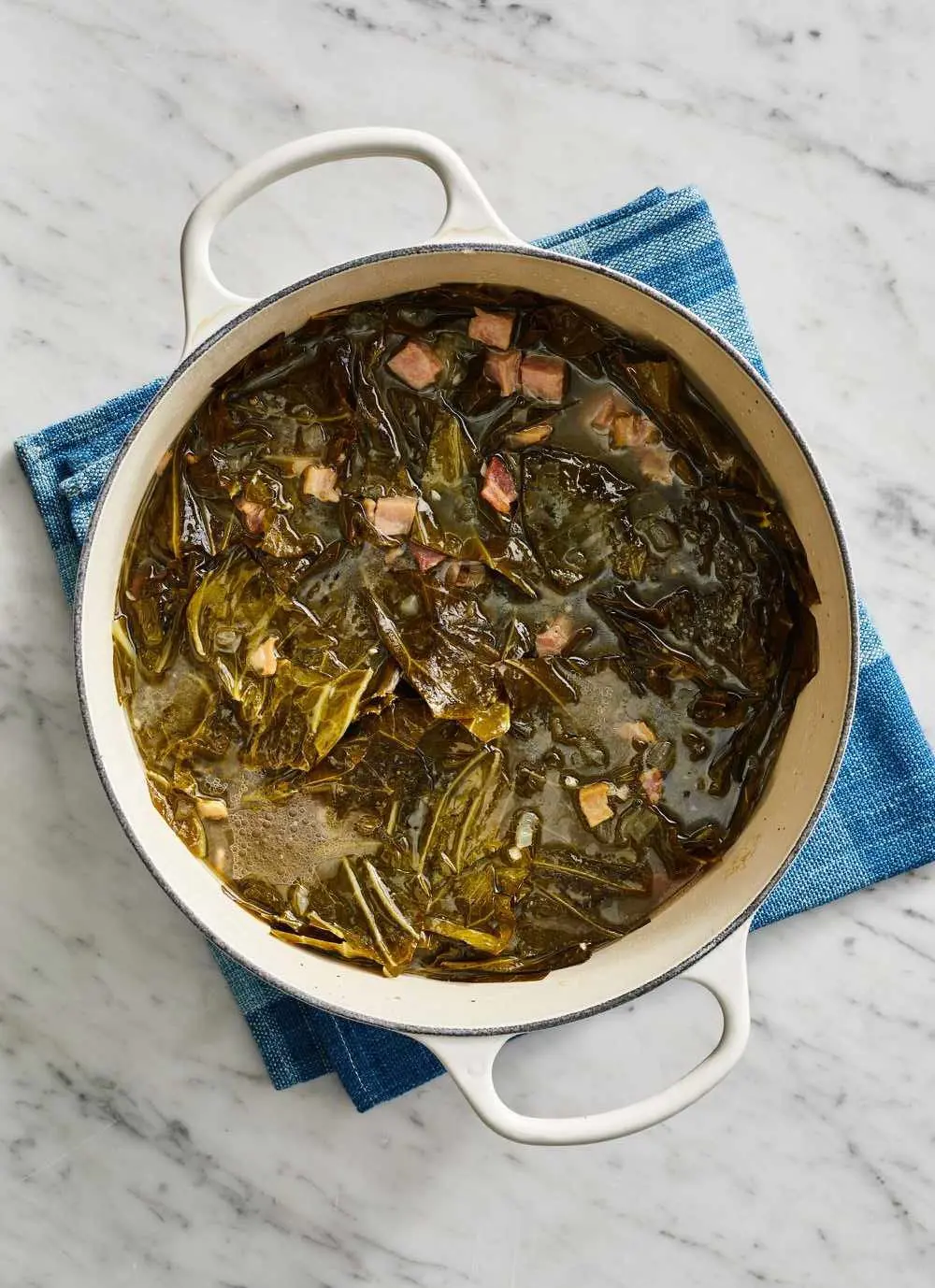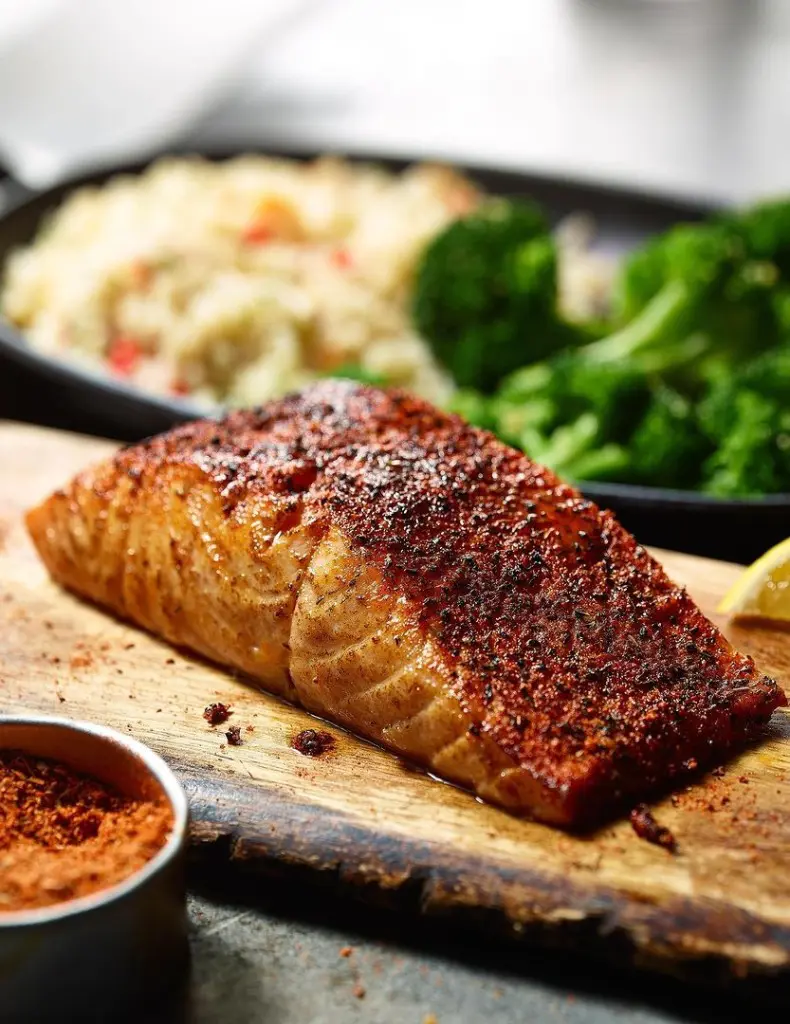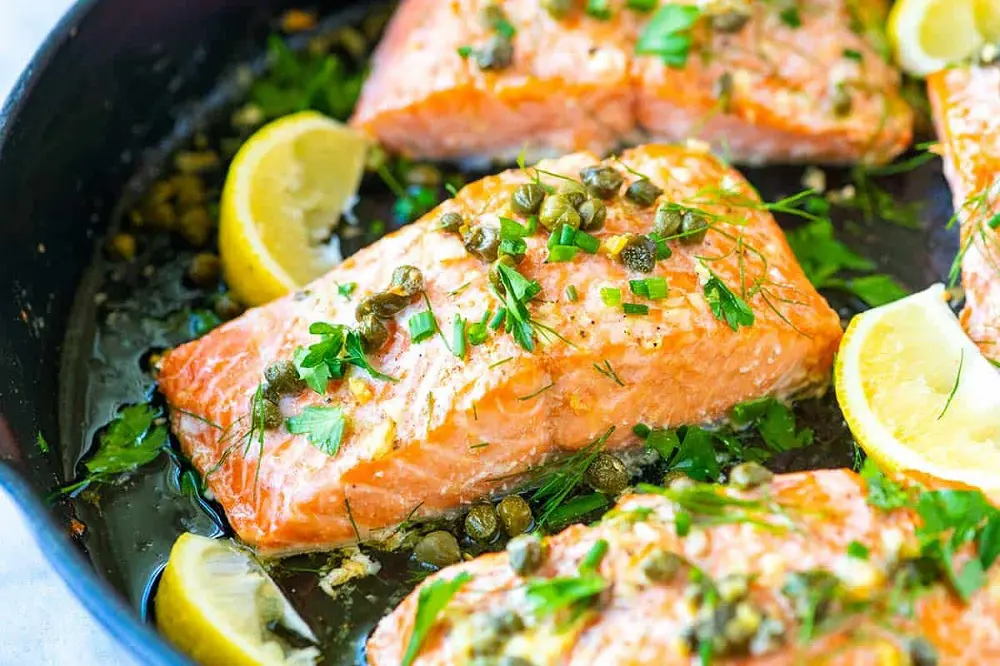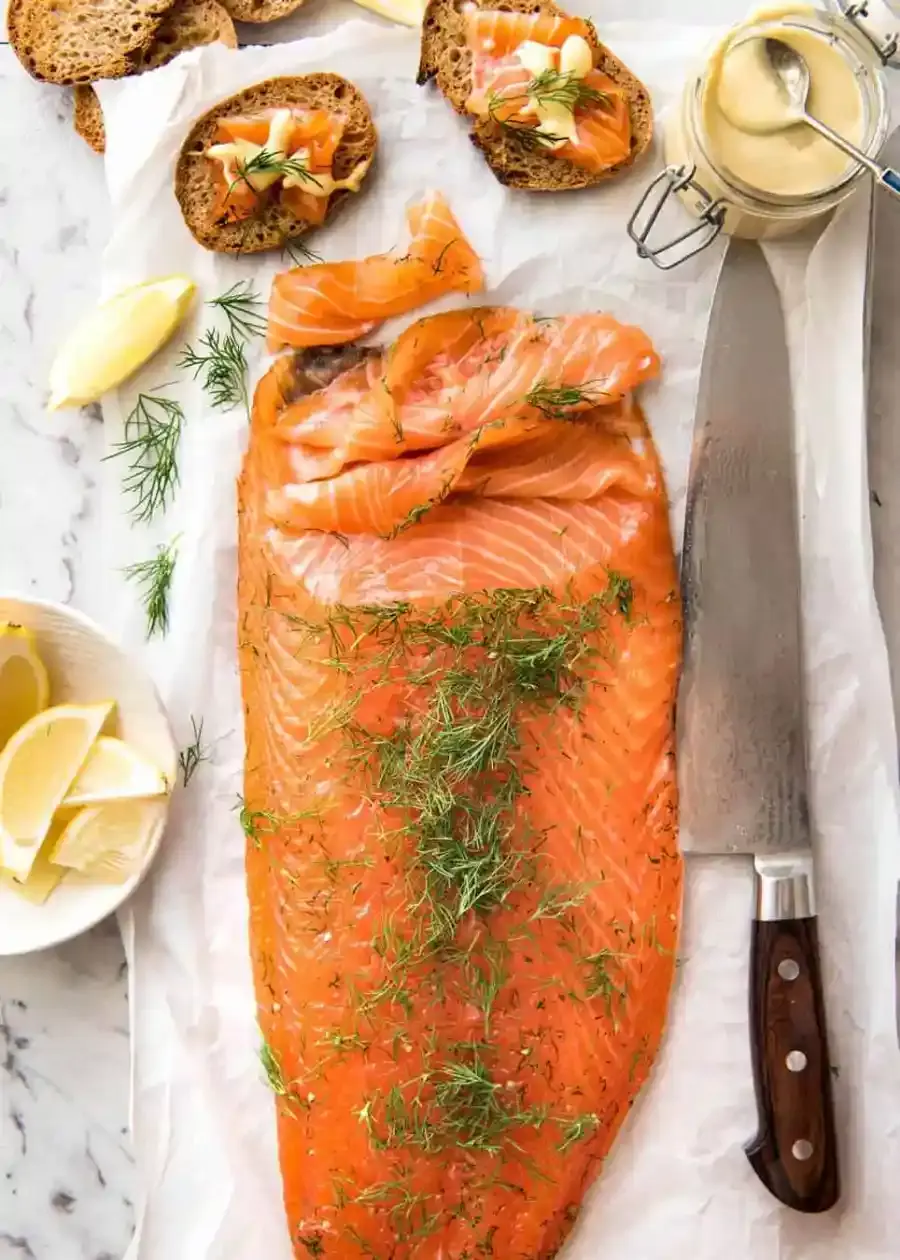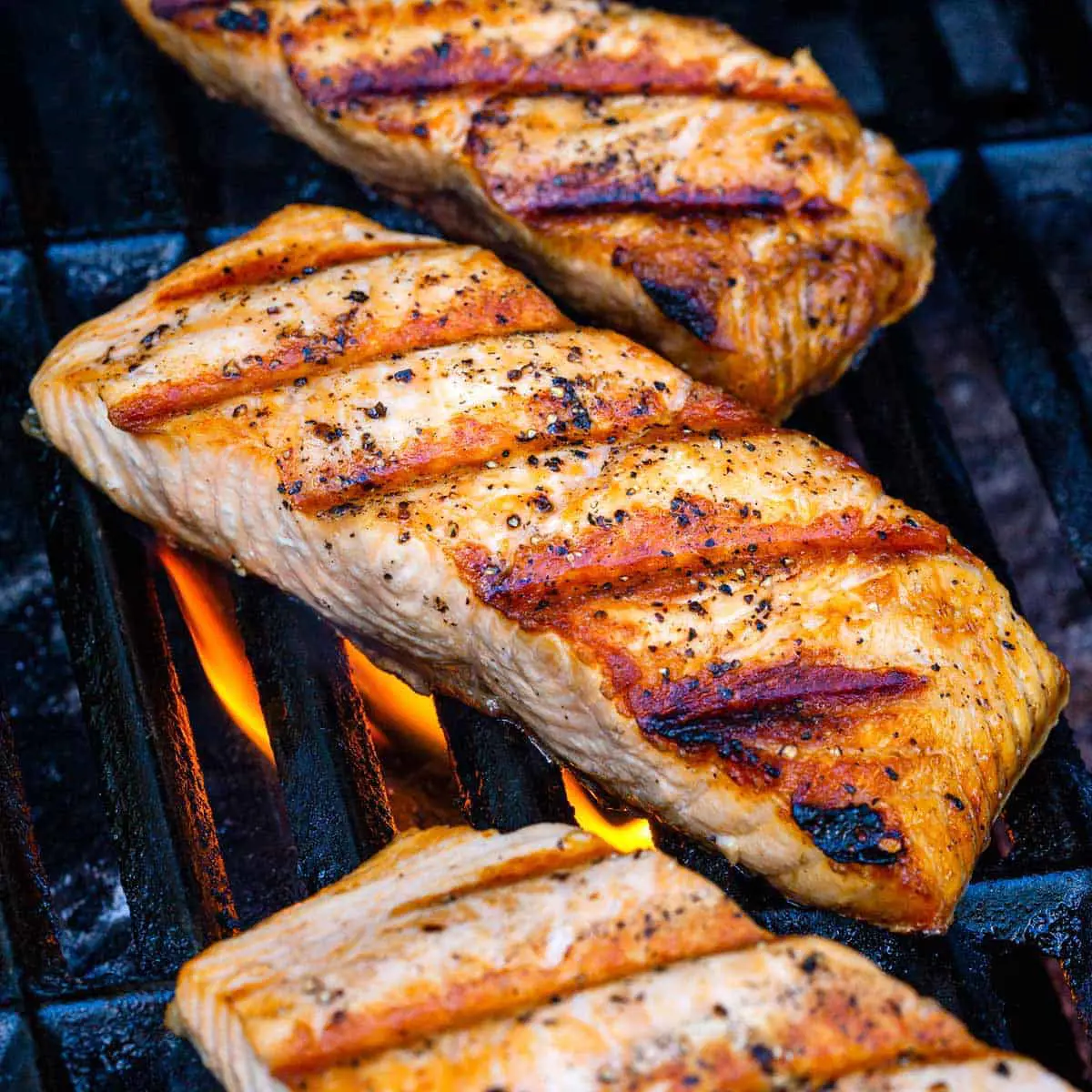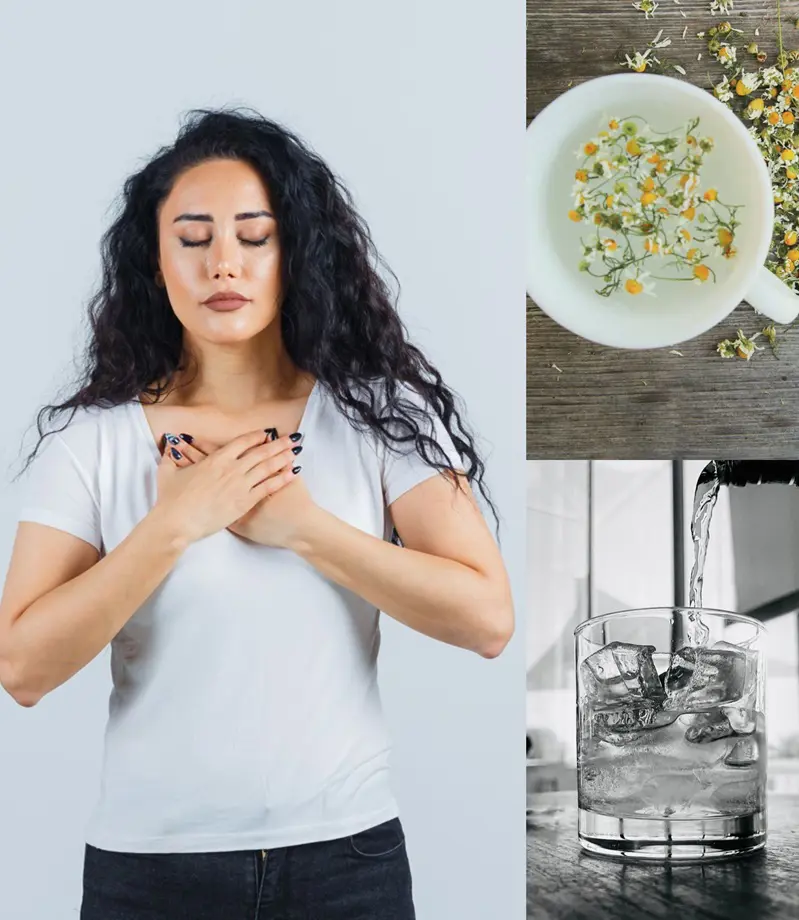How To Cook Salmon On The Stove
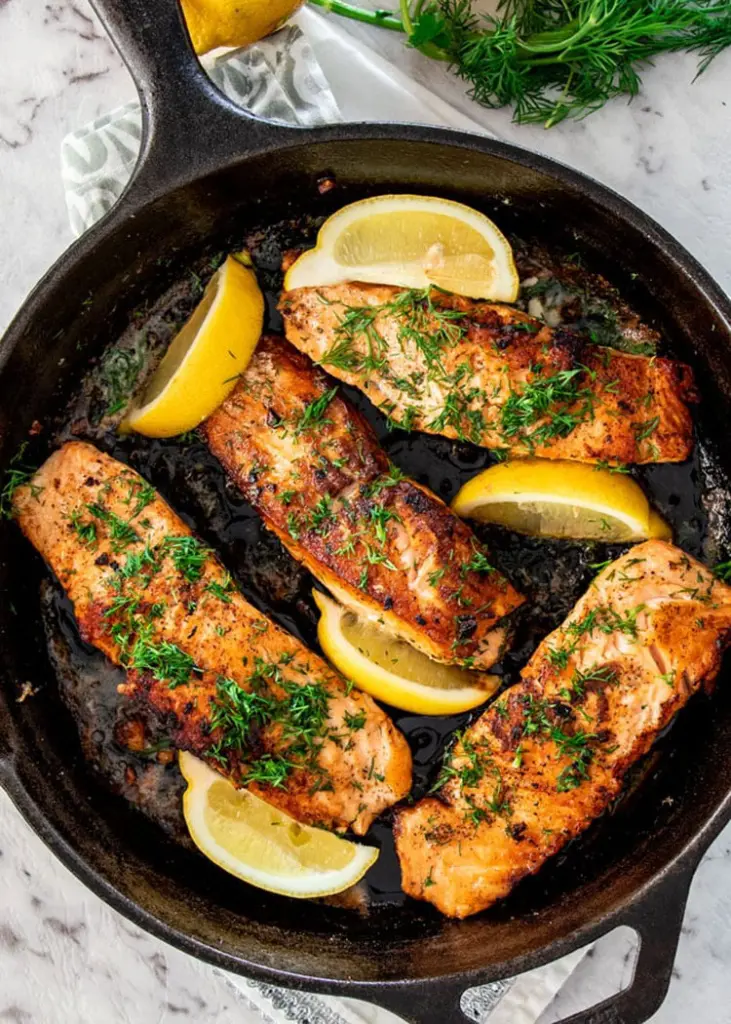
Salmon is a staple for those seeking quick and delicious weeknight dinners. This versatile fish offers a perfect balance of convenience and flavor, making it a go-to choice for busy home cooks. With a simple yet effective technique, you can transform salmon fillets into a restaurant-quality dish in your own kitchen.
Learning how to cook salmon properly ensures a perfectly cooked, tender, and flaky interior, complemented by a wonderfully crispy skin. Best of all, this impressive meal can be on your table in just 15 minutes.
Ingredients Required For Searing Salmon In A Pan
To make delicious pan-sauteed salmon you'll need these simple ingredients:
Salmon Fillets
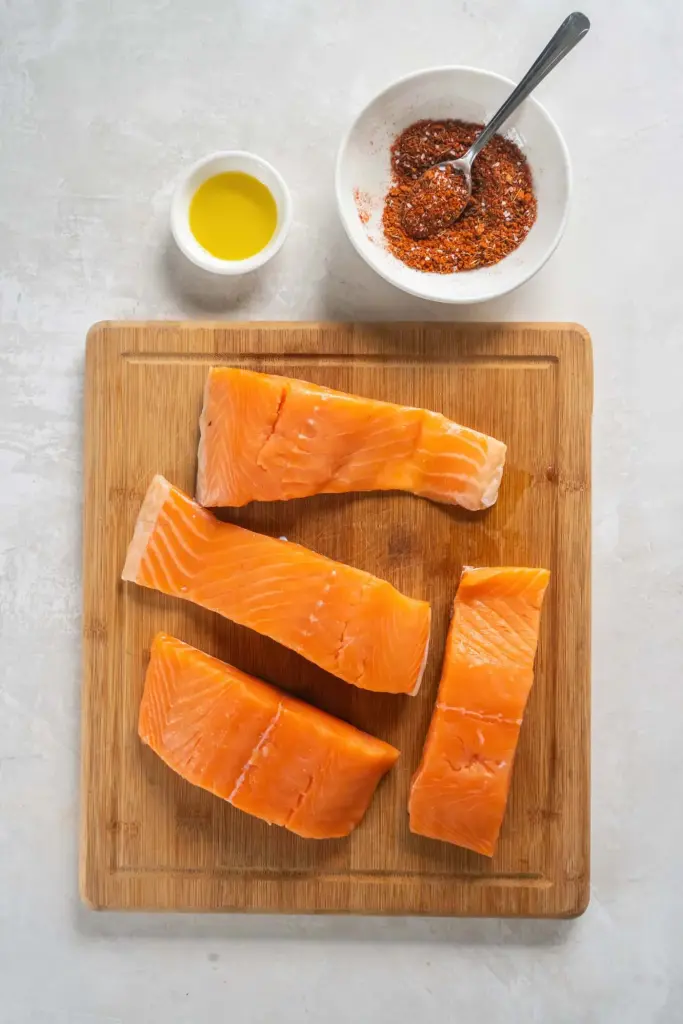
Choose skin-on fillets for the best results. The skin becomes wonderfully crispy when pan-fried, adding texture and flavor. Aim for fillets that are about 6 ounces each and of even thickness for consistent cooking.
Kosher Salt
Kosher salt enhances the natural flavors of the salmon. It helps to bring out the fish's taste without overpowering it. The coarse texture of kosher salt also makes it easier to control the amount you're using when seasoning the fish.
Black Pepper
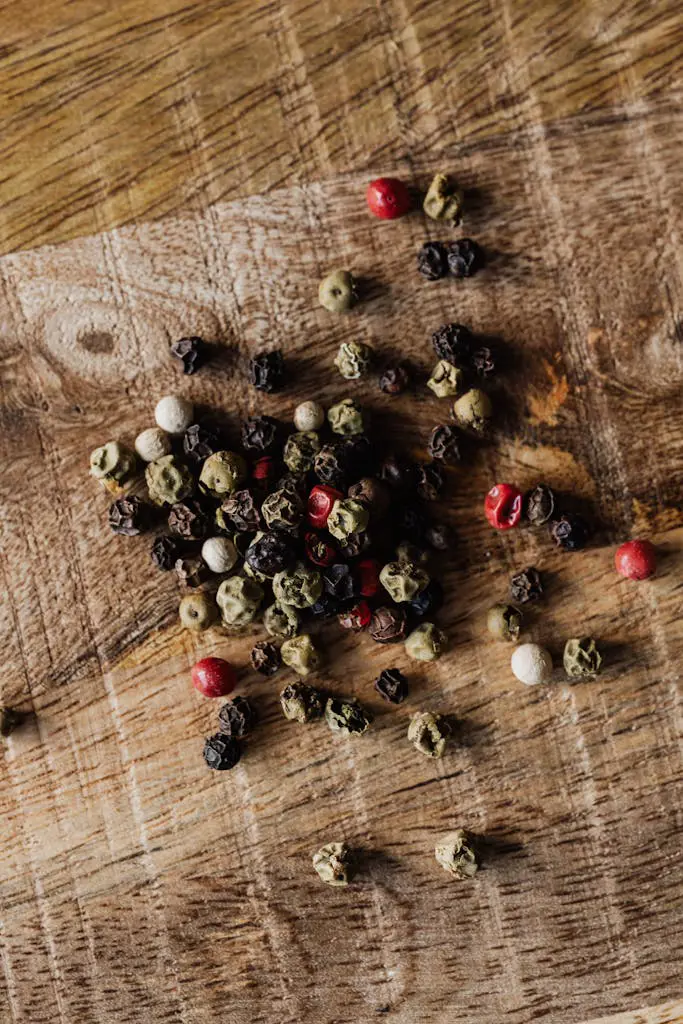
Black pepper adds a mild heat and complements the fish well. It provides a subtle spiciness that enhances the overall flavor profile of the dish without overpowering the delicate taste of the salmon.
Garlic Powder
Garlic powder provides a savory note without the risk of burning that fresh garlic might have. It offers a consistent garlic flavor throughout the dish and blends well with the other seasonings.
Dried Thyme
This seasoning offers a subtle, earthy flavor that pairs nicely with salmon. It adds a hint of herbaceous aroma and taste, complementing the fish's natural flavors without dominating them.
Olive Oil And Butter
Olive oil has a higher smoke point, making it suitable for pan-frying at higher temperatures. It helps to create a crispy exterior on the salmon without burning. Whereas, Butter adds richness and helps with browning. It contributes a creamy flavor and assists in achieving a golden-brown crust on the salmon.
Lemon Slices
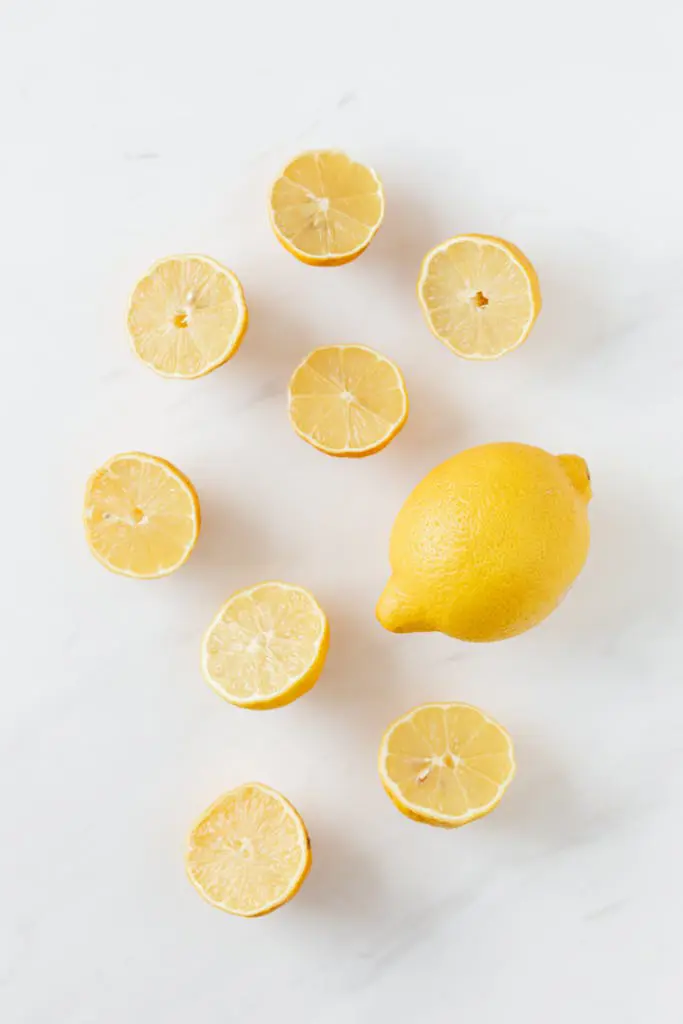
Lemon slices add a bright, citrusy flavor and can be served alongside or squeezed over the cooked salmon. The acidity of the lemon helps to cut through the richness of the fish and enhance its taste.
Chopped Parsley
Chopped parsley provides a fresh flavor and appealing color contrast. It adds a pop of green to the dish, making it more visually attractive, and contributes a light, herbaceous note that complements the salmon.
Recommended Equipment
Cast Iron Skillet
A cast iron skillet is ideal for making pan-seared salmon. Its excellent heat retention and distribution properties help achieve a perfect sear on the salmon. The skillet's ability to maintain high temperatures evenly across its surface ensures that the salmon cooks uniformly, resulting in a crispy exterior and moist interior.
Fish Spatula
A fish spatula is perfect for flipping salmon fillets when pan-searing. Its thin, flexible edge allows you to easily slide under the delicate fish without breaking it. The spatula's wide surface provides better support for the fillet during flipping, helping to maintain its shape and integrity. Yes, you do flip salmon when pan-searing to ensure even cooking on both sides.
Instant Read Thermometer
An instant read thermometer is the easiest and most accurate way to check the pan-seared salmon's internal temperature. It allows you to quickly determine if the salmon is cooked to your desired doneness without cutting into the fish and losing its juices. For medium-rare salmon, aim for an internal temperature of 125°F (52°C) at the thickest part. The temperature will continue to rise slightly after removing the fish from heat.
How To Cook A Salmon
Ingredients
- 4 salmon fillets
- Half teaspoon kosher salt
- One fourth teaspoon black pepper
- Half teaspoon garlic powder
- One fourth teaspoon dried thyme
- 1 tablespoon olive oil
- 1 tablespoon butter
- 4 lemon slices ¼-inch thick
- 2 tablespoons parsley chopped
Instructions On How Can You Cook Salmon
1. Prepare the salmon and season it
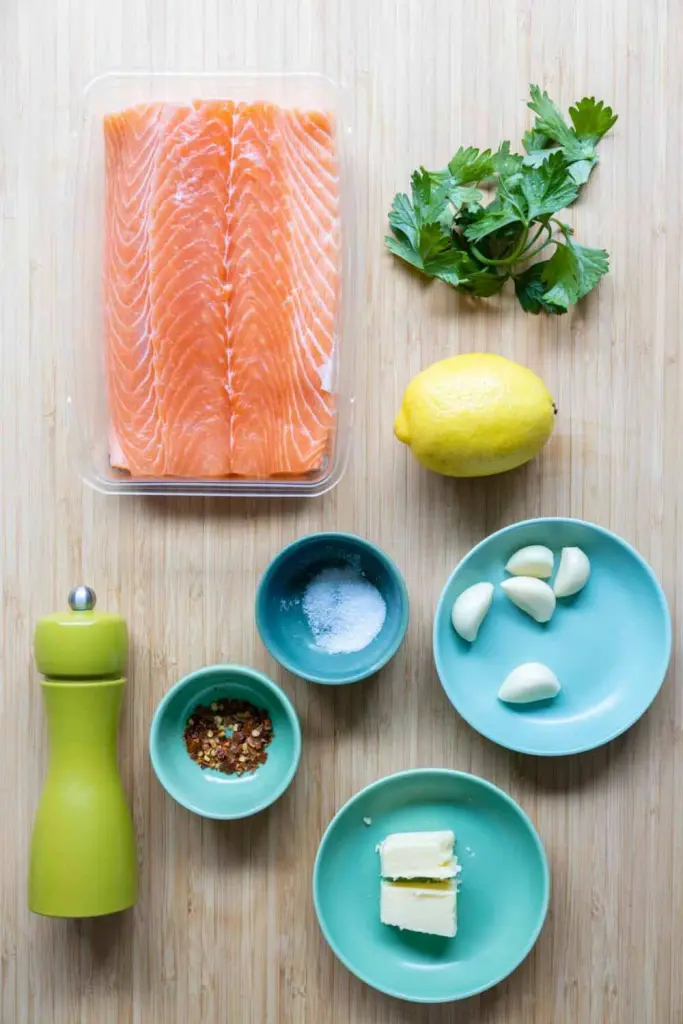
Begin by patting the salmon fillets dry with paper towels. This step is crucial as it helps achieve a crispy skin and prevents the fish from sticking to the pan. Generously sprinkle salt, pepper, garlic powder, and dried thyme over the fillets. These seasonings will enhance the natural flavors of the salmon.
2. Prepare the cooking surface
Heat a large 12-inch cast-iron skillet over medium-high heat. If you don't have a cast-iron skillet, a non-stick pan will work well too. Add olive oil and butter to the pan, swirling to coat the bottom evenly. The combination of oil and butter creates a delicious flavor and helps prevent burning.
3. Cook the salmon
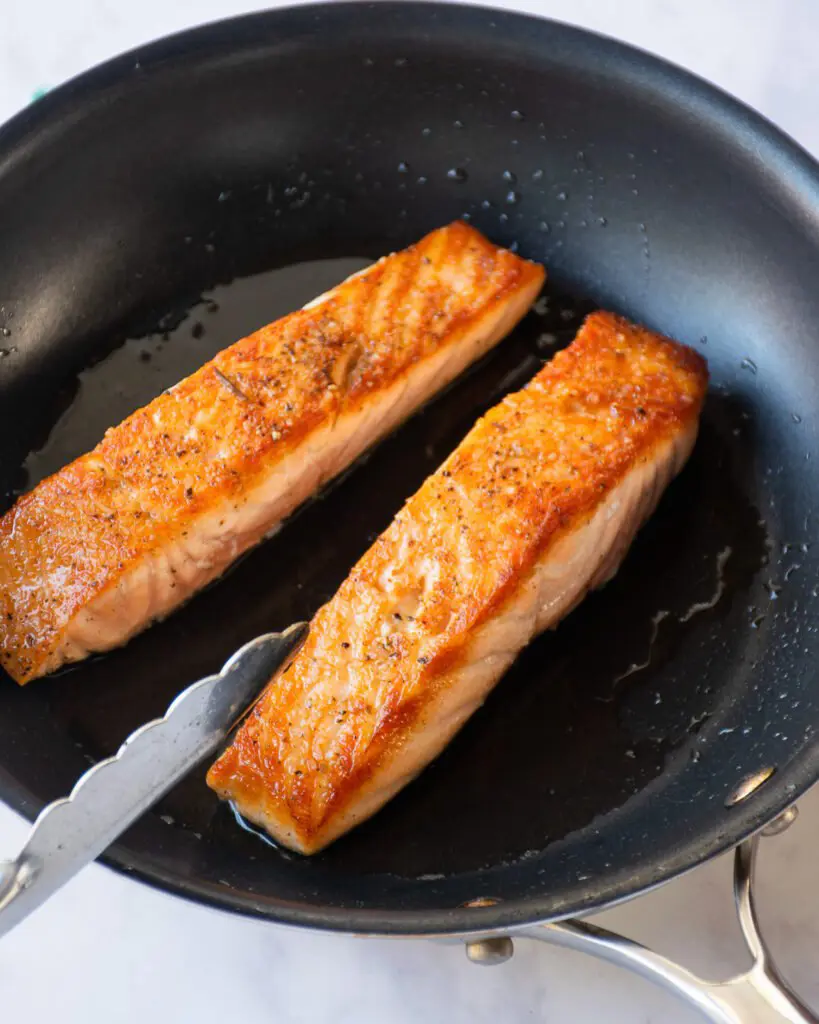
Once the butter begins to foam, carefully place the salmon fillets in the pan, skin-side down. If desired, add lemon slices to the pan for extra flavor and aroma.
4. Crisp the skin
Allow the salmon to cook undisturbed for about 4 minutes. This will create a crispy, golden-brown skin that adds wonderful texture to the dish.
5. Flip and finish cooking
Gently flip the salmon and lemon slices. Reduce the heat to medium and continue cooking for an additional 3 minutes. For thicker fillets (½ inch or more), cook the edges for about 2 minutes per side to ensure even cooking.
6. Check for doneness
How long to cook salmon? The salmon is perfectly cooked when its internal temperature reaches 145°F (63°C). You can use a meat thermometer to check this, or look for flaky, opaque flesh.
7. Serve and garnish
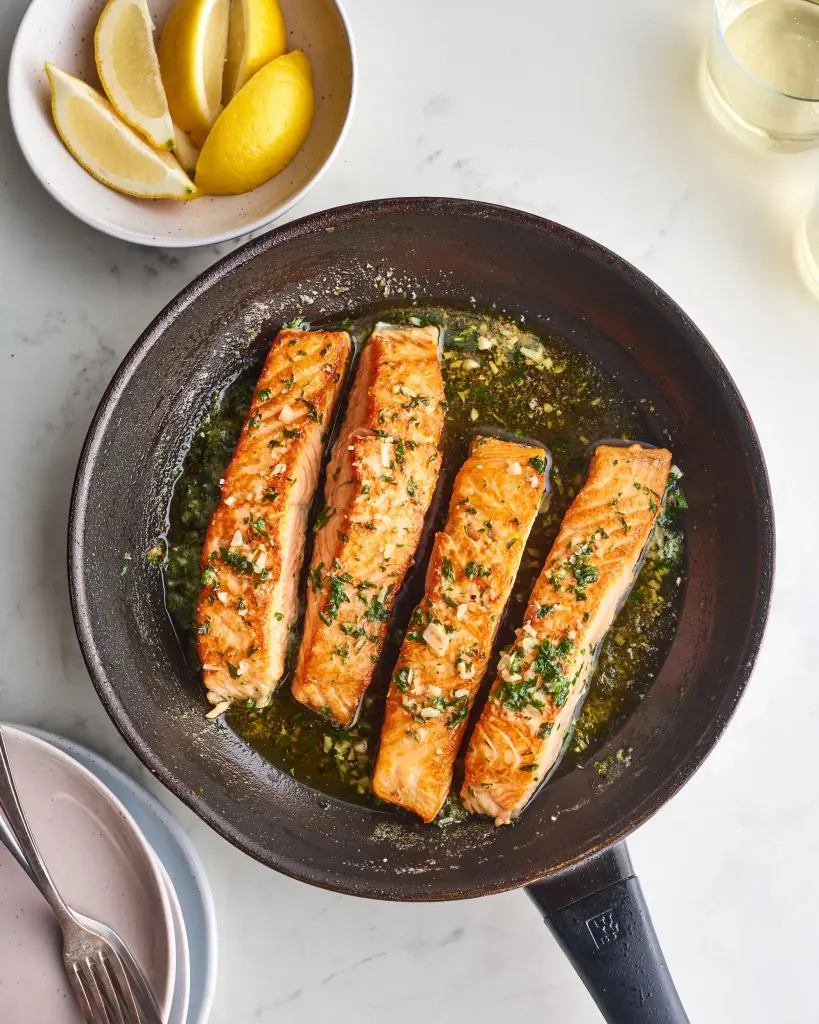
Transfer the cooked salmon fillets to a serving plate. Drizzle the flavorful pan juices over the fish for added moisture and taste. Garnish with the cooked lemon slices and a sprinkle of freshly chopped parsley for a pop of color and fresh flavor.
How Long To Cook A Salmon
Knowing when salmon is done cooking is crucial for achieving the perfect texture and flavor. While there are several methods to assess doneness, using an instant-read thermometer is the most accurate and reliable approach.
The USDA Recommendation
According to the United States Department of Agriculture (USDA), salmon is considered fully cooked when its internal temperature at the thickest part reaches 145°F (63°C). This temperature ensures that any harmful bacteria have been eliminated, making the fish safe to eat. However, at this temperature, some might find the salmon a bit too firm or dry for their liking.
Personal Preference
Many culinary enthusiasts and chefs prefer their salmon cooked to medium doneness, which is achieved at an internal temperature of about 135°F (57°C). At this temperature, the salmon retains more moisture and has a softer, more delicate texture. It's important to note that consuming undercooked fish carries some health risks, so consider your personal preferences and health concerns when deciding on your desired level of doneness.
Using an Instant-Read Thermometer
To use an instant-read thermometer, insert the probe into the thickest part of the salmon fillet. Ensure that the probe doesn't touch the pan or cooking surface, as this can result in an inaccurate reading. Wait for the temperature to stabilize before making your assessment.
Alternative Method: The Fork Test
If you don't have an instant-read thermometer, you can use the fork test to check for doneness. Here's how:
- Take a fork and gently press it into the thickest part of the salmon, right along the natural lines that run across the fillet (these are called the muscle fibers).
- If the salmon easily separates along these lines and flakes with little resistance, it's likely cooked through.
- The flesh should appear opaque and feel slightly firm but still moist.
Remember that this method is less precise than using a thermometer and requires some practice to master. With experience, you'll become more adept at judging the doneness of salmon using visual and tactile cues.
Additional Tips:
- Keep in mind that salmon will continue to cook slightly after it's removed from heat due to residual heat. You may want to remove it from the heat source just before it reaches your desired temperature.
- The color of cooked salmon can vary depending on the type of salmon and its diet. While many expect salmon to be bright pink when cooked, some varieties may appear more orange or even whitish.
- Always let your salmon rest for a few minutes after cooking. This allows the juices to redistribute throughout the fish, resulting in a more evenly moist and flavorful dish.
Tips On Getting Crispy Skin Salmon Every Time

Pan-seared salmon is a culinary delight, not just for its simplicity and quick preparation, but especially for its irresistible skin. While fish skin can be unappealing when cooked using other methods, pan-searing transforms it into a crispy delicacy.
When done right, the skin becomes thin, brittle, and savory – reminiscent of gourmet potato chips or perfectly cooked bacon. To consistently achieve this crispy perfection, follow these three essential rules:
1. Bring the salmon to room temperature before cooking
Avoid using salmon fillets straight from the refrigerator. Cold fish in a hot pan can lead to uneven cooking and may cause the fillets to seize up. Instead, remove the salmon from the fridge 15 to 20 minutes before cooking. This allows the fish to reach a temperature closer to that of the room, ensuring more even heat distribution during cooking.
2. Ensure the fillets are completely dry
Moisture is the enemy of crispy skin. Before cooking, thoroughly pat each fillet dry using paper towels or a clean kitchen cloth. Removing excess moisture prevents the fish from sticking to the pan and allows the skin to crisp up beautifully. This step is crucial for achieving that perfect, crispy texture.
3. Use a properly preheated pan
The key to crispy skin lies in using a very hot pan, but this doesn't necessarily mean cooking over high heat. Set your stovetop to medium or medium-high and allow the pan to heat up thoroughly before adding any oil.
You'll know the pan is ready when you can feel the heat radiating from its surface. At this point, add a thin layer of oil and heat until it shimmers – a visual cue that the oil is hot enough. Only then should you carefully place the salmon in the pan.
The combination of room-temperature fish, dry fillets, and a properly heated pan sets the stage for a perfectly cooked piece of salmon. This method not only enhances the texture of the skin but also ensures that the flesh remains moist and flavorful.
How To Store Salmon
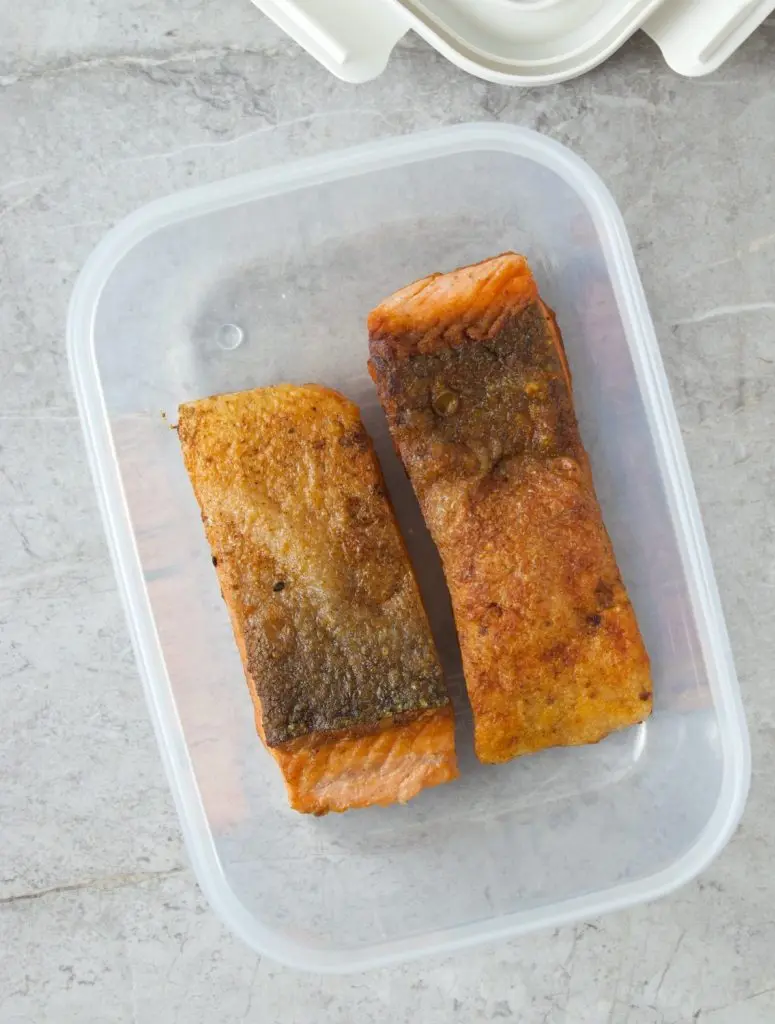
When you have leftover salmon, proper storage is key to maintaining its quality and ensuring food safety. Here are some guidelines for storing your cooked salmon:
Refrigeration:
- Place the leftover salmon in an airtight container.
- Store it in the refrigerator promptly after it has cooled to room temperature.
- Consume within 2-3 days for best quality and safety.
Container Choice:
- Glass food storage containers are an excellent option. They don't absorb odors and are easy to clean.
- If using plastic containers, ensure they are food-grade and BPA-free.
Wrapping:
- For added protection against drying out, you can wrap the salmon in aluminum foil before placing it in the container.
Labeling:
- Consider labeling the container with the date of storage to keep track of freshness.
Reheating Leftover Salmon:
When it comes time to enjoy your leftover salmon, gentle reheating is crucial to maintain its texture and flavor:
Skillet Method:
- Place a skillet over medium-low heat.
- Add a small amount of oil or butter to prevent sticking.
- Gently warm the salmon for a few minutes on each side until heated through.
- This method helps preserve the salmon's texture and prevents overcooking.
Microwave Method:
- Place the salmon on a microwave-safe plate.
- Cover with a damp paper towel to retain moisture.
- Heat in short 30-second intervals, checking frequently to avoid overcooking.
- Be cautious, as microwaves can quickly dry out fish.
Oven Method:
- Preheat your oven to 275°F (135°C).
- Place the salmon on a baking sheet and cover with foil.
- Heat for about 15 minutes, or until warmed through.
Cold Option:
- Remember, leftover salmon can also be enjoyed cold in salads or sandwiches, eliminating the need for reheating.
Important Tips:
- Avoid reheating salmon more than once.
- Always ensure the internal temperature reaches 145°F (63°C) for food safety.
- If the salmon smells off or shows signs of spoilage, it's best to discard it.
What To Serve With Salmon
Pan-seared salmon is a versatile dish that pairs well with a variety of sides. Here are some excellent options to create a well-balanced and satisfying meal:
1. Rice
Pair your salmon with a delicious rice dish for a satisfying meal. Brown rice offers a nutritious, hearty option that complements the fish well. For more flavor variety, try turmeric rice with its warm, earthy notes, or brighten up your plate with zesty lemon rice. These rice options provide a great base to soak up the salmon's juices and round out your dinner.
2. Pasta
For a comforting and filling meal, consider serving your salmon with pasta. Garlic pasta adds a aromatic and savory element that pairs wonderfully with the rich flavors of salmon. Alternatively, try mushroom pasta for an earthy, umami-rich accompaniment that creates a more complex flavor profile for your dish.
3. Vegetables
Enhance your salmon meal with a variety of vegetable sides. Grilled broccoli offers a smoky flavor and crisp texture, while sautéed spinach provides a quick, nutrient-dense option. Roasted mushrooms bring an earthy, meaty element to the plate. For a lighter touch, try air fryer zucchini or roasted tomatoes, which add a sweet and tangy contrast to the rich salmon.
4. Salad
Lighten up your salmon dinner with a refreshing salad. An Italian farro salad introduces interesting textures and Mediterranean flavors that complement the fish beautifully. For a creative twist, try a Caesar shaved Brussels sprouts salad with crispy chickpea croutons, offering a crunchy, protein-packed side that stands up well to the salmon's richness.
5. Potatoes
For a classic and satisfying pairing, serve your salmon with potatoes. Creamy crockpot mashed potatoes provide a comforting side that soaks up any delicious salmon juices. Scalloped potatoes offer a more indulgent option for a special meal. If you prefer a crispy texture, try oven-roasted potatoes, which provide a nice contrast to the tender salmon.
Recent posts
Recipe
Recipe
How To Cook Southern-Style Collard Greens
Cooking Southern-style collard greens is a beloved tradition of Southern cuisine, known for its comforting, rich, and savory flavors. These greens are slowly simmered until tender, resulting in a hearty and flavorful dish. Often prepared with smoked ...
Recipe
Best Herbs and Spices For Seasoning Salmon
Salmon is the culinary chameleon of the seafood world. It goes with everything, from light summer salads to comforting pasta dishes. Need a fast salmon fillet sizzling and without complicated recipes? The secret lies in perfect seasoning. With the ri...
Recipe
Garlic Butter Salmon Recipe
Garlic butter salmon is not only a culinary delight but also a nutritional powerhouse, offering a delectable blend of flavors and numerous health benefits. This dish combines the rich taste of salmon with the aromatic and savory notes of garlic ...
Recipe
A Comprehensive Guide To Perfect Salmon Gravlax
Salmon gravlax is a luxurious, flavorful dish that captures the essence of Scandinavian culinary tradition. This delicacy, made by curing salmon with a mixture of salt, sugar, and dill, is surprisingly easy to prepare at home. In this comprehensive g...
Recipe
14 Grilled Salmon Recipes For Perfect Summer Dinner
Salmon is possibly the most reliable dinner option for many households throughout America. So, we are confident that you already have an array of salmon-baked recipes on your corner. What we have brought for you today are grilled salmon recipes so yo...
Recipe
Best Smoked Salmon Appetizer Recipe
Smoked salmon appetizers are a timeless and elegant choice for any gathering. These offer a perfect balance of rich, smoky flavors and fresh, vibrant ingredients. These have become synonymous with casual brunches as well as upscale gatherings because...

